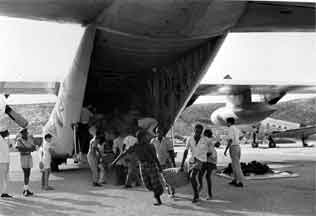1993 Americans Killed in Somali Gun Battle
 A
AEighteen American soldiers, members of the United Nations peace-keeping forces, were killed in a 15-hour gun battle with Somali rebels in Mogadishu between October 3 and 4 1993. The UN troops were sent into Somalia to maintain order in the face of civil unrest that was causing wide-spread famine and interfering with international aid relief. As a result of the incident, the US Congress put pressure on the administration to withdraw American troops. On October 7, President Clinton announced a March deadline for the withdrawal of most US troops in Somalia..
The early 1990s saw Somalia grappling with internal strife that had catastrophic humanitarian consequences. The fall of President Siad Barre's regime in 1991 plunged the nation into civil war, with various warlords vying for control of territories and resources. The conflict exacerbated an already dire famine, leading to the deaths of hundreds of thousands of Somalis. The international community, alarmed by the deteriorating situation, sought to intervene.
In response to the crisis, the United Nations launched the Unified Task Force (UNITAF) in December 1992, aiming to ensure the safe delivery of humanitarian aid and alleviate the famine. This was followed by the establishment of the United Nations Operation in Somalia II (UNOSOM II) in March 1993, which had a broader mandate, including peacekeeping and nation-building efforts. The United States played a significant role in these missions, contributing troops and resources.
The situation in Somalia was complex, with multiple factions resisting foreign intervention and the efforts to restore order. The most prominent of these factions was led by warlord Mohamed Farrah Aidid, who saw the international presence as a threat to his power.
The tensions culminated in the Battle of Mogadishu, which took place between October 3 and 4, 1993. A mission to capture two of Aidid's lieutenants went awry when American forces faced intense resistance from Somali militants. In the ensuing 15-hour gunfight, 18 American soldiers were killed, and scores were injured. The downing of two Black Hawk helicopters during the battle and the subsequent efforts to rescue the crews brought the severity of the situation to the global forefront.
The images of dead and wounded American soldiers being dragged through the streets of Mogadishu were broadcast worldwide, causing shock and outrage in the US. The public and political fallout from the incident was swift. The perception was that the US had become embroiled in a conflict with no clear endgame, and questions arose about the objectives and viability of the mission.
The US Congress, reflecting public sentiment, exerted pressure on the Clinton administration to reevaluate its involvement in Somalia. On October 7, just days after the battle, President Bill Clinton announced a March deadline for the withdrawal of most US troops from the country. While some forces remained to protect American assets and personnel, the bulk of the troops were pulled out by the stipulated deadline.
 >
>